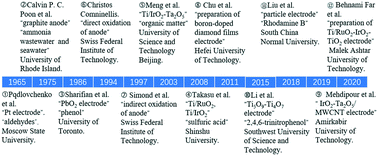Treatment of organic matter and ammonia nitrogen in wastewater by electrocatalytic oxidation: a review of anode material preparation
Abstract
The research progress of electrochemical treatment of organic matter and ammonia nitrogen in wastewater is reviewed in this work. Ti/Pt, Ti/RuxIryOz, Ti/IrO2–Ta2O5, Ti/PbO2, TinO2n−1, Ti/SnO2–Sb, boron-doped diamond, graphite, and particle electrodes were introduced. The different types of electrodes were produced primarily by thermal decomposition, electrochemical deposition, sol–gel, and chemical vapor deposition, including the pretreatment of matrix materials and coating. The degradation efficiency of organic matter (this paper primarily discusses rhodamine B [RHB] and phenol) and ammonia nitrogen in wastewater under the optimal reaction conditions was summarized. The reaction mechanism of electrochemical degradation of organic matter and ammonia nitrogen was analyzed, which is the direct electron transfer on the anode surface or the action of the strong oxidizing ˙OH radical generated by the indirect oxidation reaction. In addition, some new electrodes, such as nanostructured electrodes and porous electrodes, were used to degrade pollutants in wastewater treatment.

- This article is part of the themed collections: Environmental Science: Water Research & Technology Recent Review Articles and Best Papers 2022 – Environmental Science: Water Research & Technology


 Please wait while we load your content...
Please wait while we load your content...